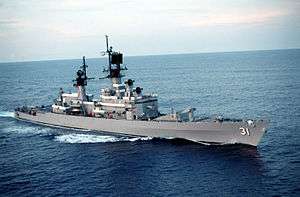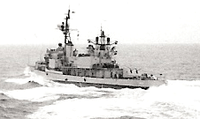Battle of Đồng Hới
| Battle of Đồng Hới | |||||||
|---|---|---|---|---|---|---|---|
| Part of the Vietnam War | |||||||
 USS Sterett | |||||||
| |||||||
| Belligerents | |||||||
|
|
| ||||||
| Strength | |||||||
|
~2 torpedo boats 3 aircraft |
1 cruiser 2 destroyers 1 frigate | ||||||
| Casualties and losses | |||||||
|
U.S claimed: 2 torpedo boats 1 MiG-17 |
U.S claimed: 2–4 wounded1 destroyer damaged 1 cruiser damaged | ||||||
The Battle of Đồng Hới was a clash between United States Navy warships and three Vietnam People's Air Force (VPAF) MiG-17F fighter bombers, several torpedo boats and shore batteries on April 19, 1972 during the Vietnam War. This was the first time US warships faced an air raid since the end of World War II.
The Battle for Đồng Hới Gulf involved fierce fire fights between Navy ships attempting to stop North Vietnamese troops and supplies transiting the coast highway in North Vietnam from reaching the battle front in Quảng Trị Province. The air raid described here marked the end of daylight raids by the Navy. Within a few weeks, however, all North Vietnamese resistance at Đồng Hới was suppressed.
Battle
The U.S. warships involved were the 7th Fleet flagship, guided missile cruiser USS Oklahoma City, the guided missile frigate USS Sterett, and destroyers USS Lloyd Thomas and USS Higbee.[1]
The American warships operating in the Gulf of Tonkin were shelling North Vietnamese coastal targets around Đồng Hới, Quảng Bình Province, North Central Coast region near the DMZ along the 17th parallel, the provisional borderline between South Vietnam and North Vietnam when they were attacked by VPAF MiGs in the first air attack on U.S. naval forces in the Vietnam War.
At approximately 17:00, USS Sterett detected three hostile aircraft approaching the navy ships. One of the MiG-17F's, flown by NVAF pilot Nguyen Van Bay, scored a direct hit on USS Higbees aft 5-inch gun mount with a BETAB-250 (250 kg/551 lb) bomb, after failing to hit his target twice on two previous attack runs. The explosion destroyed USS Higbees gun mount which was empty, as the 12 man crew having been evacuated following a "hang fire" (a round stuck in one of the barrels). The MiG was then shot down by a Terrier surface-to-air missile fired from USS Sterrett. A second MiG flown by Le Duan Xi made an attack run and then headed back toward land, USS Sterett fired a further 2 Terrier missiles at the retreating aircraft and the MiG and a missile simultaneously disappeared from the Sterett's radar, indicating a probable kill.[1]
At approximately 18:00 as the US ships withdrew to the northeast, USS Sterett detected 2 surface targets shadowing the US ships, after 30 minutes, Sterett opened fire on the targets with its 5 inch guns destroying 2 suspected North Vietnamese P 6-class torpedo boats.[1]
Aftermath
The North Vietnamese claimed that all of their aircraft had returned safely to base after the sortie,[2] and that the North Vietnamese navy had not been involved in any engagement until August 27.
Notes
References
- Dr. Itsvan Toperczer "Air war over northern Viet Nam." Squadron/Signal Publications Inc. 1998.
External links

- Analysis of the Battle of Dong Hoi by Stuart Slade. Updated 20 June 1999
- Visiting Vietnam’s War Battlefields: Dong Hoi, North Vietnam.
Coordinates: 17°28′59″N 106°35′59″E / 17.48306°N 106.59972°E